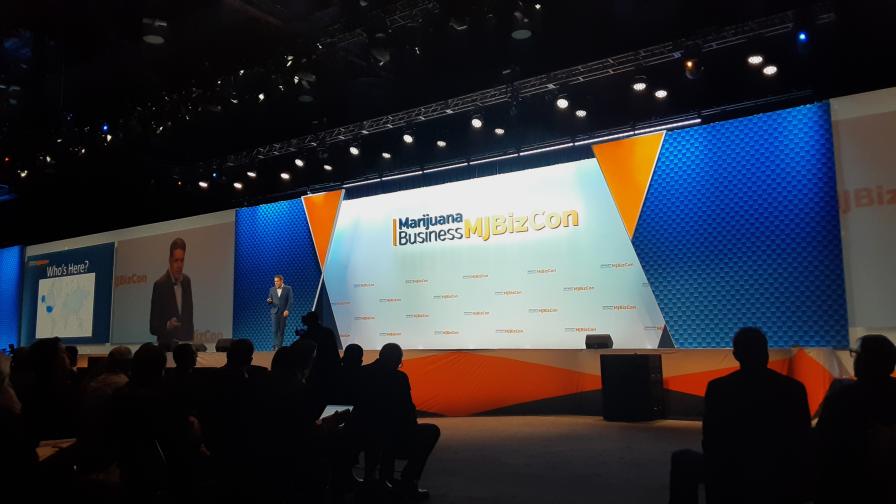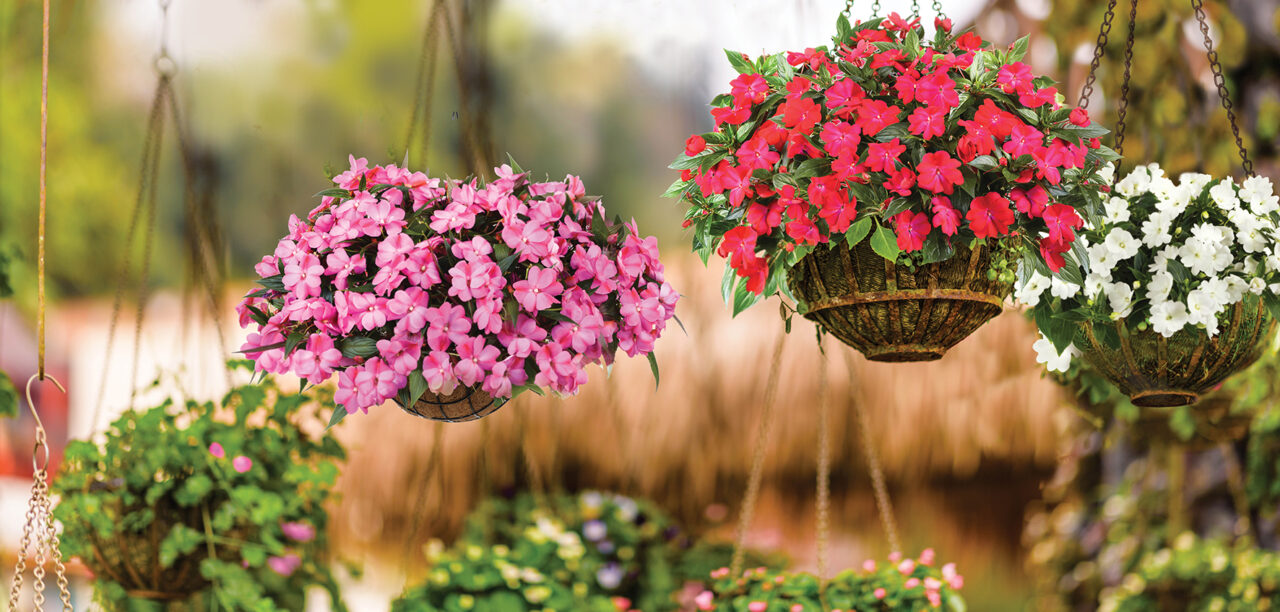MJBizCon 2019: Cannabis and Hemp Coming of Age Amidst the Chaos

Marijuana Business Daily incoming CEO Chris Walsh addresses MJBizCon attendees as part of the opening keynote on Dec. 11, 2019, at the Las Vegas Convention Center in Las Vegas, NV.
Leave the tie-dyes and patchouli oil behind and bring your nicest sports coat, and maybe a set of golf clubs if that’s your thing, because the legal cannabis industry is growing up right before our very eyes.
That’s the main takeaway after a couple days kicking around legal cannabis’ annual blowout bash, MJBizCon 2019, which crammed 35,000-plus cannabis industry movers and shakers from 75 countries into 250,000 square feet of the Las Vegas Convention Center last week, all to talk, network, deal-make and dream up the future of a potentially limitless plant market that remains shadowed in federal illegality. The 2019 version was reportedly twice the footprint of last year’s show, according to event organizers.
And despite the overwhelming-to-the-point-of-panic-inducing trade show, both from a size as well as from a sheer scope perspective — vape pen manufacturers and terpene distributors alongside greenhouse builders and AI software outfits and CBD gummy manufacturers, all trying to catch the attention of this newfangled power broker, the legal cannabis professional, there were several learnings to be had if one perhaps looked hard enough.
Welcome to the Manufacturing Age of Cannabis: I was immediately struck by the amount and scope of manufacturing equipment on display at the convention. Honestly, at first-glance it kind of reminded me of a mini-Agritechnica — which for the uninitiated is the world’s largest agricultural technology exposition, held every two years in 17 buildings across a vast campus in Hannover, Germany — slammed into one hall and exclusively focused on cannabis.
The amount and diversity of equipment on display in Vegas, shiny, expensive looking stainless steel extraction equipment and tricked up automated indoor growth chambers alongside about a thousand LED manufacturers (OK, that might be a little bit of an exaggeration, but you get the idea), not to mention all of the vape pen and pre-roll filling machines, made it clear that cannabis and hemp consumers are demanding more extracted and infused products from the market, despite all the bad press around vape pens recently. End-product processors are responding with technologies to help serve these sub-segments of the market more efficiently. On the grower side producers will need to stay on top of this segment of the market, as many will have to implement growing practices and production systems that produce a plant optimized for this end-processing market.
The ‘Midwesternization’ of the Cannabis Industry Bodes Well for Long Term Acceptance: In an industry that has long been dominated by players from both coasts, the recent approval and implementation of a recreational cannabis market in Michigan ($1.6 million in retail sales over the first eight days!) and the coming 2020 adult-use legalization of cannabis in Illinois, a market estimated at the $2-$2.5 billion mark in total valuation once the new year hits, has industry folks giddy over the growing acceptance of legal cannabis in Middle America as consumers become more comfortable with cannabis and its many forms, such as infused edible products. Illinois will be the 11th state to open for adult-use sales and the second most populous thus far (13 million residents of legal age), and its ability to successfully steward a legal cannabis presence in the Midwest could potentially open the region to further investment and penetration.
Expansion 2020 Pushes Industry Ceiling Even Higher: Legal adult-use cannabis reform reportedly has the potential to reach seven new states (New Jersey, New York, Connecticut, Vermont, New Mexico, Arizona, Florida) in the coming election year, not too mention the six states (Alabama, Mississippi, Kentucky, Nebraska, South Dakota, and South Carolina) that will vote on approval of medical marijuana programs in 2020. Further demonstrating the top-end potential of the domestic cannabis market is the fact that California alone saw $1 billion growth in its adult-use market revenues for 2019, and this despite the much ballyhooed vape-pen crisis and many California cannabis consumers reportedly turning back to the Black Market due to high tax rates at retail. Market watchers also expect domestic CBD sales volumes to double in 2020. One panelist’s evaluation of the last 12 months in legal cannabis: “The Gold Rush has indeed already begun.”
Social Equity Demanded, An Industry Responds: With Illinois’ newly approved legal-use cannabis market set for its January 2020 debut, the fact that nearly 800,000 non-violent marijuana-possession convictions will be wiped off criminal records as part of the initiative was not lost on attendees, who stressed the need for a social equity aspect included in any successful cannabis legalization or rescheduling effort going forward. And this is not simply wiping out low-level possession convictions in states where cannabis is legalized, it also involves redistributing funds from the industry to those communities that historically have been the most negatively impacted by marijuana prohibition laws (think poor and inner city), and ensuring minority communities and businesses have equal access to opportunities within the industry as well as operating licenses.
A Compliance First Focus Important to Success: With one of the strongest trends industry-wide being the proliferation and growing presence of multi-state operators (think large, vertically integrated multi-location corporations like Cresco Labs and Denver-based MedMen), the ability to produce a consistent crop while staying in compliance with the various rules and regulations across multiple states and local markets is a major challenge for growers. This is especially important for those with aspirations of operating in or expanding to the Midwest, as early market participants there are quickly learning the region is a bit different than the West Coast in that it tends to skew to a “compliance over everything” type approach at the regulatory level. Of course, this could be seen as a potential boon for longtime greenhouse growers who have already jumped through the regulatory hoops of growing ornamental or vegetable crops in multiple states and even internationally.
According to the panelists who spoke at the standing-room only session on staying in compliance, it is absolutely key for growers to understand the legal framework in each state and municipality in which they operate. Breeding a “culture of compliance” from the top of the organization or operation down to even the very lowest level employees, and having a formal compliance program in place that fits your operation and its goals and operating structure (i.e., there is no standard template) is also crucial for remaining on top of compliance issues.
Sure, compliance regulations and issues are perhaps not the most intriguing or exciting thing for us to cover as a media property, but as one of the panelists in Vegas last week stated so succinctly: “If any day you wake up and you’re not in compliance as a grower of this crop, then nothing else that you do that day matters.”
Takeaway Grower Tips: Another interesting panel discussion that took place in Vegas was the “Lessons Learned by Successful Cultivators” session, featuring four producers of varying levels of experience with legal cannabis. Among the many pearls of wisdom to come out of that talk were these main tips for growers that are maybe new to cannabis or hemp production or just now looking to get into the industry:
- Don’t Go Small: Build in plenty of room to scale-up for future growth when planning and building new facilities or a new greenhouse for cannabis. Be aggressive and think big. If you’re truly in it for the long haul, that extra space will come in handy when talk of expanding operations inevitably begins.
- Focus on Budgeting: Make sure you have a proper build out of your budget before diving into a project. Know the costs and build in some room for unexpected costs.
- Technology Integration: Make sure whatever technologies you invest in can be integrated together into a single ecosystem. Check that the fertility and HVAC/climate control and lighting aspects of your operation can all work together and exchange data between systems.
- Hire Experience: Have an experienced team in place from the very start. If you don’t have the experience, hire it and bring it in-house.
- A Robust Maintenance Program is a Must: Having a maintenance program in place for all your facilities and the growing and processing tech contained there within can save on headaches and potentially costly machine downtime.
- Murphy’s Law Still Applies: As always, be prepared for anything and everything to go wrong during your cannabis or hemp grow, and have viable backup plans in place in case of an unexpected emergency.









